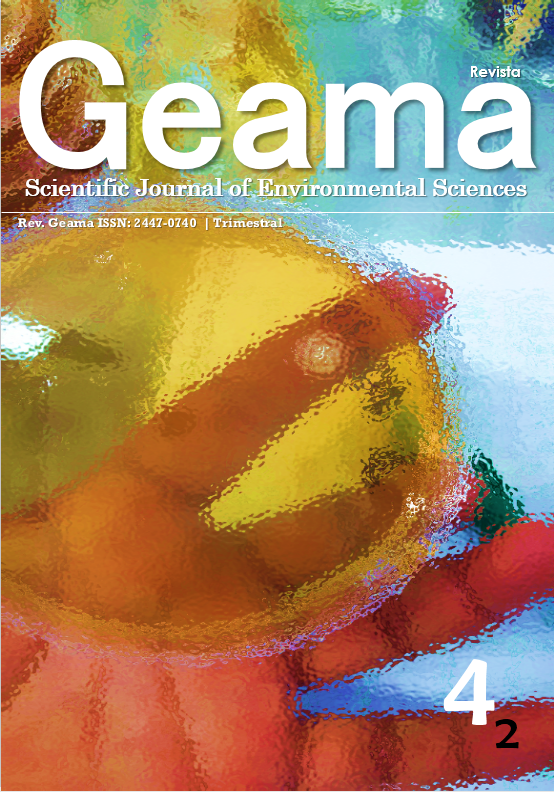Agricultura de Precisão: Programas Tecnológicos no Brasil
Abstract
Precision agriculture (AP) is recognized as a technological innovation tool because when applied in a preventive way during agricultural production, it improves the economic and management aspects, minimizing losses of agricultural inputs and environmental risks in relation to conventional agriculture. This article describes government incentive and free trade programs for assessing productivity, analyzing fertility deficiencies, soil and plant physical and chemical characteristics, as well as evaluating the development of pests and diseases that may occur during production.Downloads
References
BERNARDI, A. C. C.; NAIME, J. M.; RESENDE, A. V.;
BASSOI, L. H.; INAMASU, R. Y. 2014. Agricultura de
Precisão: Resultados de um novo olhar. Embrapa.
BERNARDI, A. C. C.; INAMASU, R. Y. 2014. Adoção da
Agricultura de Precisão No Brasil. In: NOME DOS
AUTORES. Agricultura de Precisão: Resultados de
um novo olhar. Embrapa.
BRAGA, R. 2009. Viticultura de Precisão. Associação
dos Jovens Agricultores de Portugal. 1a ed.
BRASIL. 2015. Ministério das Relações Exteriores.
Disponível em: <http://www.itamaraty.gov.br/ptBR/component/tags/tag/15-ocde-organizacaopara-a-cooperacao-e-o-desenvolvimentoeconomico.
>. Acesso em: 11 de março de
BRASIL. 2013. Ministério da Agricultura, Pecuária e
Abastecimento. Agricultura de precisão/Ministério
da Agricultura, Pecuária e Abastecimento.
Secretaria de Desenvolvimento Agropecuário e
Cooperativismo. – Brasília: Mapa/ACS.
EMBRAPA. 2014. Visão 2014-2034: o futuro do
desenvolvimento tecnológico da agricultura
brasileira. — Brasília, DF: Embrapa.
IBGE. 2017. Instituto Brasileiro de Geografia e
Estatística. Estatística da Produção Agrícola.
Disponível em:
<ftp://ftp.ibge.gov.br/Producao_Agricola/Fascic
ulo_Indicadores_IBGE/estProdAgr_201706.pdf.>.A
cesso em: 15 de abril de 2017.
FAO, 2017. Organização das Nações Unidas para
OCDE Alimentação e Agricultura. Perspectivas
Agrícolas no Brasil: desafios da agricultura
brasileira 2015-2024. Disponível em:
<http://www.fao.org.br/download/PA20142015C
B.pdf>. Acesso em 22 de fevereiro de 2017.
MOURA, R. M. 2008. Rachel Carson e os Agrotóxicos,
Anos após a Primavera Silenciosa. Anais da
Academia Pernambucana de Ciência
Agronômica, V. 5, n. 6, p. 44-52.
PORTAL BRASIL. 2016. Economia e Emprego.
Disponível em:
<http://www.brasil.gov.br/economia-eemprego/2016/06/capacidade-de-estocagemde-graos-sobe-3-3-no-pais>.
Acesso em: 18 demarço de 2017.
ROBERTS, R. K.; ENGLISH, B. C.; LARSON, J. A.;
COCHRAN, R. L.; GOODMAN, W. R.; LARKIN, S. L.;
MARRA, M. C.; MARTIN, S. W.; SHURLEY, W. D.;
REEVE S, J. M. 2004. Adoption of site-specific
information and variable rate technologies in
cotton precision farming. Journal of Agricultural
and Applied Economics, v. 36, n. 1, p. 143-158.
VIEIRA-FILHO, J. E. R.; FISHLOW, A. 2017. Agricultura e
indústria no Brasil: inovação e competitividade.
Brasília: Ipea, 2017. 305p.
SILVA, K. E.; BARRETO, T. S. C. P.; SHINOHARA, N. K. S.;
MACHADO, J.; ANDRADE, J. S. C. O. 2017.
Precision Agriculture in the Promotion of
Sustainable Development. Revista Geama. v. 3, n.
p. 42-46






